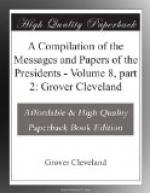The first object, starting place, or terminus a quo, is this northwest angle of Nova Scotia. It is the corner of the British Province designated by themselves. It was presumed, and it is still believed, that they knew the identical spot; we have a right to demand of them to define it. In the treaty of 1783 they were disposed to define it, and hence they say it is that angle which is formed by a line drawn due north from the source of the St. Croix to those highlands which divide the rivers that flow into the St. Lawrence from those which flow into the Atlantic Ocean.
Nothing can be more clear than that the British negotiators of the treaty of 1783 had reference to their east and west line between Canada and Nova Scotia. This in 1755-56 was matter of controversy between France and England, the French claiming that it was far south and the British strenuously contending that these very highlands were even more north than we have endeavored to fix them.
The controversy resulted in a war, which, after the capture of Quebec, was terminated by the peace of 1763, whereby Great Britain obtained both sides of the line, and she then established the north line of Nova Scotia about where we contend it should be. So far from admitting that a due north line from the monument will not intersect the highlands intended by the treaty of 1783, the State of Maine has always insisted, and still insists, that no known obstacle exists to the ascertaining and accurately defining them, and thus establishing the terminus a quo, to wit, the northwest angle of Nova Scotia. It would seem strange, indeed, that this line, so fully discussed and controverted between the English and French in 1755-56, should have been left unsettled still when both Provinces became British. It is impossible to imagine such ignorance of so important a point as this northwest angle, so often referred to and spoken of as a notorious monument.
The peace of 1783 was considered by Great Britain as a grant by metes and bounds. The boundaries were prescribed, and this northwest angle was the commencement. Twenty years only before this (1763) Nova Scotia had been organized as a distinct Province, then including what are now Nova Scotia and New Brunswick, and this angle was referred to as a boundary without hesitancy or doubt. Indeed, the treaty itself, as if to make assurance doubly sure, fixed it where a due north line from the source of the St. Croix will intersect those highlands which divide the rivers which flow into the river St. Lawrence from those which flow into the Atlantic Ocean. This source of the St. Croix has been determined and a monument fixed there by the commissioners under the fifth article of the treaty of 1795 (Jay’s). Now the assumption that the north line from this monument will intersect or meet no such highlands is entirely gratuitous.




